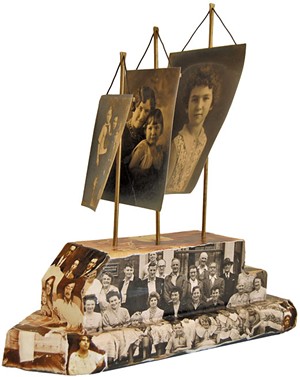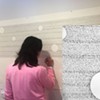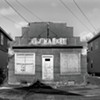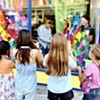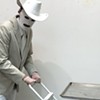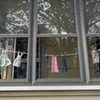Published April 29, 2015 at 10:00 a.m.
When Cabot artist Janet Van Fleet responded to an artists' call, she didn't know what she was getting herself into. Neither did Brattleboro painter Hannah Earley or any of the 320 other artists from around the world who participated in "Telephone: An International Arts Experiment." They couldn't have known because the work as a whole didn't exist until April 20, 2015, when it all appeared online.
"Telephone" is the brainchild of poet, composer and violinist Nathan Langston and is presented by the New York-based Satellite Collective, a multidisciplinary arts incubator he cofounded. The project echoes the children's game Telephone (aka Operator or Grapevine), in which a message is whispered from person to person. In the process, that message is transformed.
The "message" in this case wasn't words, but a communication passed from one artist to another via original works of art. The project got its impetus five years ago when Langston and his wife moved to New York City from Portland, Ore. They knew only one other person in NYC. In an essay introducing "Telephone" on his website, Langston writes about feeling lonely and homesick.
"On that first broiling night in the sweat-sticky August of this colossal city, I sat out on a friend's fire escape with a glass of wine and, as sirens passed below, remembered a prayer," he writes. Known as the Breton Fisherman's Prayer, it begins: "Oh God, thy sea is so great, and my boat is so small."
When Langston conceived of "Telephone," he made those words a prompt for the first artist to interpret. The next artist would receive and interpret the first one's resulting artwork, and so on.
The first artist, New York-based Jana Weaver, created a painting titled "Oh Lord" (gouache on paper). It depicts a naked woman launching a paper boat under a starry sky. Weaver sent her painting to Bob Holman, also of New York City, who interpreted it in his poem "Naked Night."
Next up was New York photographer Casey Kelbaugh, who writes in his online artist's notes that he struggled with reinterpreting the poem. Finally, he came through with an abstract photograph taken in the New Mexico desert. Holman's poem was reinterpreted into music and a sculpture by yet more artists, and the project was off and running.
Still, after 15 months, "Telephone" had resulted in just eight artworks. By then, Langston was focusing on ballet and music composition with Satellite Collective, so he put "Telephone" aside. "But I couldn't get it out of my mind," Langston writes in his essay. "That first sequence of works was so stunning that I dreamt about it. The idea woke me up at night."
Two years later, Satellite Collective's online director, Daniel Talsky, helped reframe the concept. He realized "Telephone" could exist on a much larger scale if the collective transferred the project to the internet. A completed interpretation could be given to two or three other artists to reinterpret simultaneously. The sequence would no longer be one straight line; "Telephone" would branch out like a tree.
All told, the project took five years and resulted in 315 original works by artists from 159 cities in 42 countries. A graphical depiction of "Telephone" resembles a subway map — or a constellation.
On April 20, "Telephone" was unveiled around the world when the link went live. Participating artists finally learned what the original message was and discovered what their own works of art had inspired.
Van Fleet, one of the two Vermonters who participated, says she "liked that it was a game, not deadly serious and career minded. There was a kind of idealism about both the idea and the process that I admired."
Her telephone "whisper" arrived via email. "Nathan sent me four to five views of a single work by an artist in Istanbul," Van Fleet tells Seven Days. "The images made it pretty easy, as they were from another sculptor [Julie Upmeyer], not a musician, poet or videographer, as might have happened."
Artists across 13 disciplines participated in the project, "so there's a huge variety of voices and media, all trying to translate and transmit the same original message across very different platforms," Van Fleet says.
Upmeyer's work was Van Fleet's only window into "Telephone" until its conclusion. "I had one month to complete a piece that translated as closely as I was able, in my medium, the intent of the artist whose work was sent to me," Van Fleet explains.
The sculptor, who characteristically works with found wood and other items, built a wooden boat and covered it with a collage of found photographs. "The masts are made with brass rods, and the sails are original early-20th-century portrait photographs," she says.
Langston tells Seven Days that when he received Van Fleet's photographs of her sculpture, "I practically jumped out of my chair." The Vermont artist says she later learned that her piece was almost a mirror of the very first prompt, that fisherman's prayer. Langston wrote to Van Fleet:
I consider your boat made of old family photographs to be almost the thesis of the project. It could have been made directly from the original message, but took such a wild journey through the forms to get there. When I got your work in my inbox, I just got goose bumps.
Van Fleet says it's fascinating, "when you wander around on the website, to discover how much water, blue and boat imagery there [is]." Many of the participating artists have described seeing these recurrent connections.
Van Fleet credits Langston with persevering over five years with little financial backing. "What's amazing is that it was worth his time, that he gave his time to create this great gift of 'art soup' and invited everybody to come and partake!"
Viewers may find themselves similarly mesmerized when browsing the "Telephone" artworks online or taking the curated tour. The project's results are presented almost seamlessly, whether they be music or video, or images of paintings, sculptures, collages or other types of work. And the message comes through.
"Telephone: An International Arts Experiment," conceived by Nathan Langston, produced by Satellite Collective. telephone.satellitecollective.org
The original print version of this article was headlined "'Telephone': What Happens When Artists Get the Call"
More By This Author
Speaking of...
-

Morrisville Sculptor Thea Alvin Is Recognized With $100,000 Craft Award
May 22, 2024 -

Q&A: Catching Up With the Champlain Valley Quilt Guild
Apr 10, 2024 -

Video: The Champlain Valley Quilt Guild Prepares for Its Biennial Quilt Show
Apr 4, 2024 -

Q&A: Meet a Family in Waterbury That Embraces Halloween Year-Round
Feb 14, 2024 -

Video: Goth Family in Waterbury: Sarah, Jay and Zarek Vogelsang-Card
Feb 8, 2024 - More »
Comments
Comments are closed.
From 2014-2020, Seven Days allowed readers to comment on all stories posted on our website. While we've appreciated the suggestions and insights, right now Seven Days is prioritizing our core mission — producing high-quality, responsible local journalism — over moderating online debates between readers.
To criticize, correct or praise our reporting, please send us a letter to the editor or send us a tip. We’ll check it out and report the results.
Online comments may return when we have better tech tools for managing them. Thanks for reading.
































